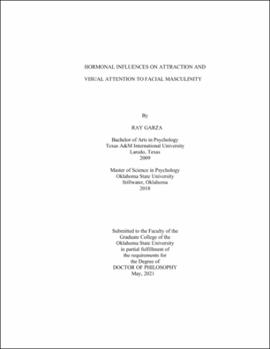| dc.contributor.advisor | Byrd-Craven, Jennifer | |
| dc.contributor.author | Garza, Ray | |
| dc.date.accessioned | 2021-09-24T13:33:01Z | |
| dc.date.available | 2021-09-24T13:33:01Z | |
| dc.date.issued | 2021-05 | |
| dc.identifier.uri | https://hdl.handle.net/11244/330874 | |
| dc.description.abstract | Differences in reproductive success caused by competition within and between the sexes have resulted in selective pressures in females to favor specific features in males. Research on women's mate preferences has indicated that women often prefer men that display masculine physical characteristics, likely due to masculinity's association with immunocompetence, resource acquisition, and protection. Traditionally, studies have incorporated a forced choice rating (2afc) where women choose a preference towards a feminine or masculine male face. Findings have consistently shown that masculine faces are preferred and considered attractive, but the hormonal underpinnings of these preferences have been mixed. The current study investigated the ovulatory shift hypothesis, which suggests that women prefer masculine men during peak fertility. The current study used an eye tracking paradigm to measuring women's visual attention to facial masculinity across the menstrual cycle. Estradiol (E) and progesterone (P) were collected to determine if salivary biomarkers influence visual attention to masculine faces during peak fertility in a short- and long-term mating context. Women (N = 81) provided saliva samples at three time points throughout their menstrual cycle and were asked to rate and view men's faces that had been manipulated to appear feminine and masculine. Overall, masculine faces were viewed longer compared to feminine faces and this was dependent upon mating context, where women viewed masculine faces longer for a long-term relationship. There was not any evidence suggesting that peak fertility (i.e., high E/P ratio) was associated with viewing facial masculinity, but there was evidence to suggest that hormones were associated with visual attention to men in general. Additionally, women's self-perceived mate value played a significant role in the amount of visual attention displayed to facial masculinity, demonstrating higher visual time to masculine faces as women's self-perceived mate value increased. In line with sexual strategies theory, there was evidence to suggest that mating context, facial masculinity, and mate value are important in mate choice; however, there was no evidence to suggest that women's mate choice was dependent upon fertility status. | |
| dc.format | application/pdf | |
| dc.language | en_US | |
| dc.rights | Copyright is held by the author who has granted the Oklahoma State University Library the non-exclusive right to share this material in its institutional repository. Contact Digital Library Services at lib-dls@okstate.edu or 405-744-9161 for the permission policy on the use, reproduction or distribution of this material. | |
| dc.title | Hormonal influences on attraction and visual attention to facial masculinity | |
| dc.contributor.committeeMember | Krems, Jaimie Arona | |
| dc.contributor.committeeMember | Towner, Mary | |
| dc.contributor.committeeMember | Lovern, Matt | |
| osu.filename | Garza_okstate_0664D_17128.pdf | |
| osu.accesstype | Open Access | |
| dc.type.genre | Dissertation | |
| dc.type.material | Text | |
| dc.subject.keywords | attraction | |
| dc.subject.keywords | fertility | |
| dc.subject.keywords | mating | |
| dc.subject.keywords | sexual selection theory | |
| dc.subject.keywords | sexual strategies theory | |
| dc.subject.keywords | visual attention | |
| thesis.degree.discipline | Psychology | |
| thesis.degree.grantor | Oklahoma State University | |
